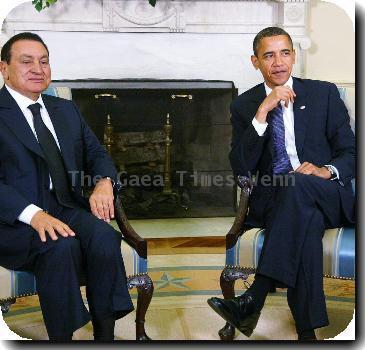On home turf of his astronaut critics, Obama to make pitch for changes in direction of NASA
By Seth Borenstein, APThursday, April 15, 2010
Obama: America’s still got adventures in space
CAPE CANAVERAL, Fla. — Near the launch pads where U.S. space voyages begin, President Barack Obama will try to reassure workers that America’s space adventures sail on despite the coming end of space shuttle flights.
And Obama on Thursday will also try to explain why he aborted his predecessor’s return-to-the moon plan in favor of a complicated system of public-and-private flights that would go elsewhere in space, with details still to be worked out.
As Obama landed at the Kennedy Space Center’s shuttle landing facility — the first president to do that in 32 years — supporters were pitching his plan as needed change.
“It’s exploration, not transportation,” said Planetary Society executive director Louis Freedman, while waiting for the president’s motorcade to arrive.
Planetary Society officials and academics said the president’s speech — the first on space exploration away from Washington since John F. Kennedy’s Rice University call to go to the moon — puts Mars more in focus than ever before.
“The U.S. is going to new exciting destinations beyond the influence of Earth gravity and make discoveries that we can’t predict.” television personality and Planetary Society vice president Bill Nye, “The Science Guy,” said at the space center. “I think the concern is change. People are just afraid of change.”
But with a canceled moon program, the Obama plan is a tough sell. So Obama is bringing deal sweeteners with him to Kennedy Space Center, pitching work that will save jobs, provide training for others and extend the life of the International Space Station.
And he’s doing it on what once was the home turf of his most prominent critics.
This is the place where astronauts Neil Armstrong, Jim Lovell and Eugene Cernan became American heroes. And they’re all opposed to his ideas, warning they will end America’s supremacy in space.
Obama will speak in the building the Apollo astronauts lived in before they launched.
Obama will outline a strategy that “will provide more jobs for the area, greater investment in innovation, more astronaut time in space, more rockets launching sooner, and a more ambitious and sustainable space program for America’s future,” White House press secretary Robert Gibbs said.
The Obama space plan relies on private companies to fly to the space station, giving them almost $6 billion to build their own rockets and ships. It also extends the space station’s life by five years and puts billions into research to eventually develop new government rocket ships for future missions to a nearby asteroid, the moon, Martian moons or other points in space. Those stops would be stepping stones on an eventual mission to Mars.
Florida elected officials are hoping for one more thing: More space shuttle flights. Sen. George LeMieux, R-Fla., in a conference call with reporters Thursday morning said that the Kennedy Space Center director told him there were enough parts for one or two more shuttle flights. That’s what Florida officials want today, he said.
This all happens as the orbiting space shuttle Discovery winds down another day in orbit, with problems getting a cargo carrier off the space station.
After Discovery lands, there are just three more shuttle flights, a retirement ordered by then-President George W. Bush in 2004 to pay for the return-to-the-moon mission, dubbed “Apollo on steroids.” This year, Obama canceled the moon mission, called Constellation, saying it was not sustainable and was long underfunded.
But to Armstrong, Lovell and Cernan this was killing more than a moon program, but the entire American manned space program.
“Without the skill and experience that actual spacecraft operation provides, the USA is far too likely to be on a long downhill slide to mediocrity,” the three Apollo veterans wrote in a letter to the media. “America must decide if it wishes to remain a leader in space.”
To counter, the administration brought out Armstrong’s Apollo 11 crewmate Buzz Aldrin on Air Force One, along with Sen. Bill Nelson, D-Fla., and Rep. Suzanne Kosmas, a vulnerable Democrat who represents Kennedy Space Center.
“The overall purpose is American leadership,” Aldrin said of the space plan Thursday morning.
In a statement released by the White House, Aldrin earlier said, “The steps we will be taking in following the president’s direction will best position NASA and other space agencies to ultimately send humans to Mars and other exciting destinations as quickly as possible.”
Earlier this week, the administration said it would rescue a small part of the moon program: its Orion crew capsule. But instead of taking four astronauts to the moon, the not-yet-built Orion will be slimmed down and used as an emergency escape pod on the space station.
When Obama speaks Thursday afternoon, he will be in the vast launch complex’s Operations and Checkout building. It is the place where Orion is scheduled to be eventually prepared for launch.
LeMieux said the saving of Orion made him feel slightly better about the president’s proposal. But he added that by killing off the moon plan, the president needs to provide more details on his alternative: “What’s his destination and what’s his time frame?”
Technically, this is more than a speech. It is a space conference, organized by the White House, with four sessions after the president talks to go into more depth about the details and challenges ahead.
Obama becomes the first sitting president in 12 years to visit Kennedy Space Center, but he won’t stay long. After a couple hours he’ll jet to Miami and spend more time in South Florida at two Democratic National Committee fundraisers.
On the Net:
NASA: www.nasa.gov/
(This version CORRECTS SUBS 3rd paragraph to correct to first presidential visit in 32, sted 22, years; Obama speaks at 2:50 p.m. EDT. Will be led.)
Tags: Astronomy, Barack Obama, Cape Canaveral, District Of Columbia, Florida, Higher Education, North America, Planets, The Moon, United States



